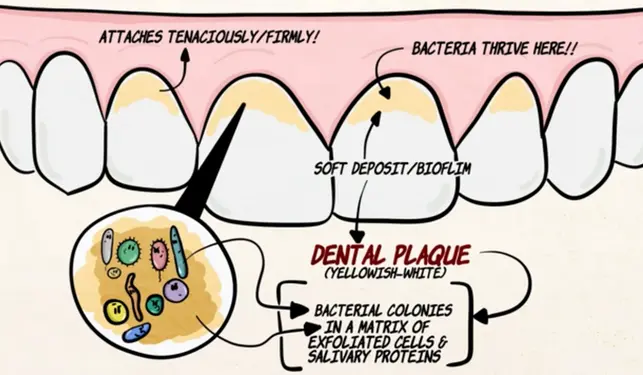Hello everyone, Dr. Mostafizur Rahman Khandaker here, lead dentist at Mostafizur’s Dental in Cumilla. Today, I want to discuss dental plaque, a sticky film that can lead to cavities and gum disease. Brushing and flossing regularly are crucial, but I’ll share more ways to keep your smile healthy!
What is Dental Plaque?
Dental plaque is a sticky film of bacteria that gathers on teeth, leading to decay and gum issues. It’s made of bacteria, food bits, and saliva. Plaque is colorless but can stain teeth. Regular brushing and flossing remove it.
Plaque quickly forms after eating, harboring bacteria that feed on sugars. This leads to acid production, damaging enamel. If left, plaque hardens into tartar, causing more severe problems. It often hides in the crevices of molars. Good oral hygiene prevents plaque buildup, protecting teeth and gums.

The Four Stages of Dental Plaque Formation: A Sticky Situation
Dental plaque, that sticky film on your teeth, isn’t just a random collection of bacteria. It’s a complex, well-organized community of microbes working together as a biofilm. This biofilm goes through a fascinating four-stage life cycle, with each stage contributing to its growth and persistence.
Stage 1: Attachment of Bacteria to a Solid Surface
The initial step in plaque formation is the attachment of bacteria to the tooth surface. This attachment is facilitated by the formation of an acquired pellicle, a thin film derived from salivary glycoproteins that makes the surface receptive to colonization by specific bacteria.
Stage 2: Formation of Microcolonies on the Surface
Following attachment, bacteria form microcolonies on the tooth surface. This stage involves reversible adhesion of pioneer bacteria to the acquired pellicle. Gram-positive cocci are typically the first microorganisms to colonize the teeth, initiating the biofilm formation process.
Stage 3: Formation of Mature Subgingival Plaque Biofilms
As the biofilm matures, adherent bacteria secrete extracellular polysaccharides to form the biofilm matrix. This rapid growth stage leads to the development of microcolonies within the matrix, with additional varieties of bacteria adhering to the early colonizers through coaggregation.
The biofilm complexity increases as structural stratification occurs within the biofilm, and the thickness of the biofilm grows.
Stage 4: Steady State and Detachment
In the steady state phase, bacteria within the biofilm slow their growth or become static. Bacteria deep within the biofilm may show signs of death, while those near the surface remain intact.
During this phase, crystals may be observed in the interbacterial matrix, potentially indicating initial calculus mineralization. Surface detachment and sloughing occur, with some bacteria dispersing to form new biofilm colonies.
Are Dental Plaque and Tartar the Same? Break The Myth
While both dental plaque and tartar can wreak havoc on your smile, they’re not exactly twins. Here’s a breakdown to clear things up:
Tartar, also called calculus, is the calcified version of dental plaque. Imagine tiny plaque monsters having a mineral shower! This hardens the plaque, making it impossible to remove with just brushing and flossing.
Tartar forms above and below the gum line, irritating gums and increasing the risk of gingivivits (gum disease). Regular dental cleanings are your best bet to remove tartar and keep your smile sparkling.
Plaque Vs. Tartar: Brushing Up on the Bad Guys in Your Mouth
Here’s a quick table to keep things clear:
| Aspect | Dental Plaque | Tartar |
| Formation | Sticky bacteria buildup on teeth. | Hardened plaque due to mineral buildup. |
| Removal | Can be removed by brushing/flossing. | Requires dentist’s help to remove. |
| Appearance | Soft, colorless film on teeth. | Hardened, off-white or yellow substance. |
| Impact | Causes tooth decay and gum disease. | Can lead to more serious dental issues. |
| Prevention | Brushing and flossing regularly. | Regular dental cleanings are essential. |
Verdict
Dental plaque and tartar are both harmful to oral health but differ in their formation and removal methods. While plaque can be managed with good oral hygiene, tartar requires professional intervention. Regular dental visits are crucial for keeping both at bay and maintaining a healthy smile.
Signs and Symptoms of Dental Plaque
- Fuzzy Teeth Feeling: Running your tongue across teeth reveals a rough, fuzzy coating.
- Persistent Bad Breath: Halitosis that doesn’t improve with brushing could signal plaque buildup.
- Yellow/Brown Teeth Stains: Plaque can cause unsightly discoloration on tooth surfaces over time.
- Tooth Sensitivity: Plaque erosion exposes dentinal tubules, leading to teeth pain or discomfort.
- Tooth Surface Cavities: Small pits or holes on teeth indicate advanced tooth decay.
- Gums Turning Red: Healthy gums are pink and firm. Red, swollen, or bleeding gums after brushing could be a sign of plaque-induced inflammation.
- Loose Tooth Trouble: In severe cases, plaque buildup can lead to gum disease, which can eventually loosen teeth.
7 Common Causes of Dental Plaque
Plaque buildup is a leading cause of tooth decay and gum disease. Let’s find the causes behind developing dental plaque.
1. Poor Oral Hygiene Habits
Failing to brush and floss regularly allows food debris and bacteria to accumulate on and between teeth. This provides an ideal environment for plaque to form and harden into tartar. Brushing at least twice daily and flossing once removes plaque before it can mineralize.
2. Sugary and Starchy Foods
Bacteria in plaque thrive on sugars and starches from foods like candy, cookies, bread, pasta, chips, etc. As they metabolize these carbohydrates, they produce acids that erode tooth enamel over time. Limiting sugary/starchy snacks and drinks reduces the fuel for plaque acids.
3. Acid Attack
As bacteria munch on sugar, they release acid. This acidy villain weakens tooth enamel, the shield protecting your teeth. Over time, weak enamel can lead to cavities, ouch!
4. Lack of Saliva
Saliva helps neutralize plaque acids and rinse away food particles. Dry mouth caused by certain medications, health conditions or radiation treatment reduces this protective saliva flow. This allows plaque to accumulate more easily on teeth. Drinking water and using saliva substitutes can help.
5. Smoking and Tobacco Use
The chemicals in cigarettes, cigars and chewing tobacco create an environment conducive to plaque growth. Tobacco also stains plaque a yellow or brown color, making it more visible. Quitting tobacco improves your ability to control plaque.
6. Certain Medications
Some medications reduce saliva production as a side effect, leading to chronic dry mouth. Others like oral contraceptives, antidepressants and heart medicines may also affect plaque levels. Let your dentist know your current medications.
7. Genetic Factors
Research shows some people may be genetically predisposed to produce larger amounts of plaque or have plaque that mineralizes more quickly into hard tartar. This makes them more prone to plaque buildup despite good hygiene habits.
Preventing Plaque Buildup: 7 Easy Steps By Dr. Khandaker

Maintaining good oral hygiene is the key to preventing plaque buildup. Here are some effective strategies recommended by Dr. Mostafizur Rahman Khandaker:
1. Brush Regularly
Brush your teeth at least twice a day, for 2 minutes each time, using a soft-bristled toothbrush and fluoride toothpaste. Brush all surfaces of your teeth to remove plaque.
2. Floss Daily
Floss once a day to remove plaque and food debris from between your teeth, where your toothbrush can’t reach.
3. Use Mouthwash
Rinse with an antibacterial mouthwash to help reduce bacteria that cause plaque.

4. Eat Tooth-Friendly Foods
Limit sugary and starchy foods, which feed the bacteria that produce plaque. Instead, choose crunchy fruits and vegetables that can help scrub your teeth.
5. Chew Sugarless Gum
Chewing sugarless gum can increase saliva flow, which helps neutralize acid and wash away food particles.
6. See Your Dentist Regularly
Get professional cleanings and checkups at least twice a year to remove hardened plaque (tartar) that brushing and flossing can’t.
7. Consider Dental Sealants
Your dentist may recommend dental sealants, a thin protective coating applied to the chewing surfaces of your back teeth to prevent plaque and decay.
8. Other Options to Prevent Dental Plaque
- Explore cranberry products, which may deter cavity-causing bacteria.
- Stay Hydrated: Drinking water helps produce saliva to rinse away plaque.
- Breaking bad habits of smoking.
Remember to Store mouthwash out of reach of children to prevent accidental ingestion.
Diagnosis of Dental Plaque
During a routine dental checkup, dentists can identify plaque buildup by visually examining your teeth. They may also use tools like dental X-rays to detect cavities or bone loss.
Additionally, measuring the depth of pockets around your teeth helps assess signs of gum disease. These diagnostic methods enable dentists to pinpoint the extent of plaque accumulation and any related dental issues accurately.
Effective Treatments for Plaque and Tartar Removal
Only dentists can safely remove hardened plaque or tartar from teeth surfaces. They use special instruments to scrape off tartar during professional cleanings. Attempting tartar removal at home risks damaging tooth enamel.
For plaque and tartar buildup, dentists may suggest sealants or fluoride treatments. Sealants prevent plaque formation on chewing surfaces. Fluoride slows bacterial growth, reducing decay risk. Prescription toothpastes or mouthwashes also combat plaque effectively.
If tartar causes gum disease, dentists perform scaling and root planing. This deep-cleaning procedure removes tartar deposits from under gums. Laser therapy or osseous surgery may follow for advanced cases. Regular cleanings every six months maintain optimal oral health.
Common Questions About Dental Plaque
What causes plaque teeth?
Plaque buildup is caused by poor brushing/flossing habits, sugary foods, dry mouth, smoking, and certain medications. Bacteria feed on sugar, releasing acid that attacks teeth.
What is plaque vs tartar?
Plaque is a soft film of bacteria. Tartar (calculus) is hardened plaque that brushing can’t remove and requires a dentist’s cleaning.
Should I pick plaque off my teeth?
It’s best not to pick plaque. Brushing and flossing twice daily removes it safely. If plaque hardens, see a dentist for professional removal.
Are there different types of dental plaque?
Yes, there are two main types: supragingival plaque (above the gum line) and subgingival plaque (below the gum line), which can cause more problems.
How can I prevent plaque buildup?
Brush twice daily, floss once daily, use mouthwash, limit sugary foods, drink water, and see your dentist regularly for cleanings.
Takeaway by Dr. Mostafizur Rahman Khandaker
Remember, plaque buildup is preventable! By following these tips and scheduling regular dental checkups at Mostafizur’s Dental, you can achieve and maintain optimal oral health. A bright, healthy smile is within reach! Let’s work together to keep your smile plaque-free.


